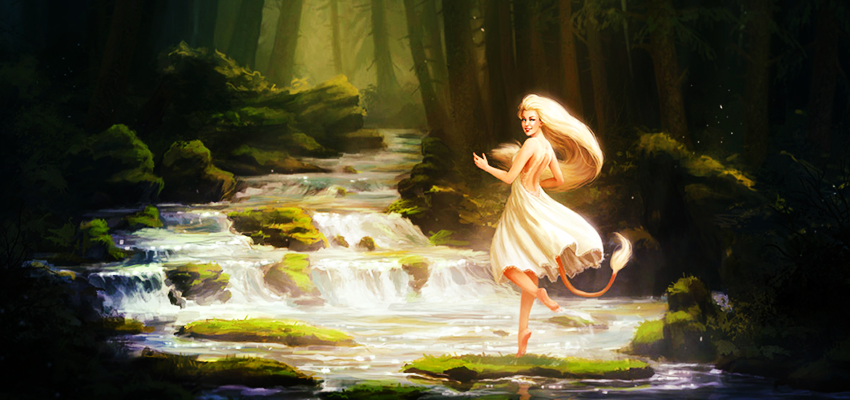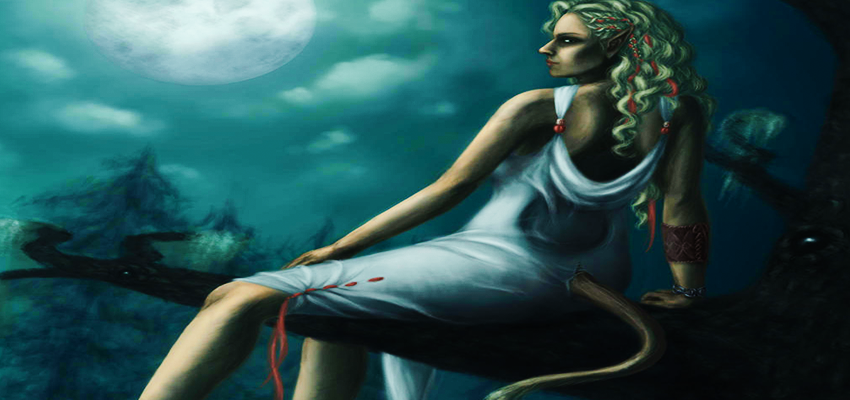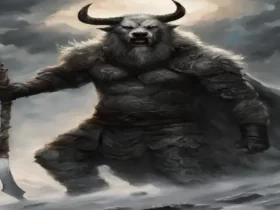Norse mythology consists of a collection of tales about the gods, goddesses, mythical creatures and heroes of Norse mythology. What sound like masculine words are actually female mythical creatures from Norse mythology. The “Huldra” or “Hulder” are really fair and exceptionally kind, which have made them popular figures in Scandinavian folklore. A Huldra is a seductive forest spirit from Scandinavian folklore who appears as a beautiful woman with long, flowing hair.
Huldra can be found in many different myths around all Nordic and Germanic people, so they are often thought of as being the origin of many contemporary mythological creatures. Elves, for example, share a resemblance to Huldra with their love of secluded wooded places. Japanese Yokai Jorogumo also share some similarities with the Huldra like using their power to shape-shift. Even Slavic Samodivas have some resemblances with Huldra by causing chaos and destruction when provoked.
1 Huldra Is A Seductive Forest Being Of Scandinavian Folklore

The Huldra are a type of forest beings or creatures found in Germanic and Scandinavian folklore. They are known for their beauty as well as their seductiveness. Huldra are a type of mythical creature that have been traditionally described as female, beautiful and often deadly.
2 Huldra/Hulder Prefers To Live In Secluded Villages
The name usually translates to “secret” or “covered one,” which probably means Huldra tried to always stay hidden from humankind due to their mystical nature that they possessed.
3 From Forest Spirit To Ulda, They Have Several Names Given By Different Cultures

The Huldra also has many different names, they are sometimes referred to as “forest spirit” or “skogsrå”, “pine tree Mary” or “Tallemaja” in Sweden and “Ulda” in Sámi (Lapplander) legends.
4 Male Counterpart Of Huldra Is Dubbed As Huldrekall With Ogre Or Troll Like Appearance
Occasionally male versions of the Huldras called “Huldrekall” are also mentioned in Norwegian tales. But, The huldrekall are the opposite of the female counterparts who dwell in the forest. They are so different that they can be considered as a completely separate species. The Huldra are beautiful and seductive, but the Huldrekall are visually grotesque and ugly creatures who live underground.
5 They Are Protectors Of Nature & Mountain Cattle

Norse folklore portrays the Huldra as nature’s steward and, in some cases, even protectors. They’re believed to be a kind of rå or nature spirits who live in the ocean. Based on Norse myths, they are related to aquatic sjörå or havsfrö spirits that represent the origin of mermaid folklore.
6 Some Legends Tell God Cursed A Lady To Disappeared From Humanity & Eventually She Became A Huldra
For centuries, Christianity was accepted across Germany and Scandinavia. All of the sudden, a new origin story for the Huldra emerged. It said God once visited a nearby woman’s house but she only had time to wash half of her children. The woman, who was ashamed of her children’s unwashed bodies, tried to cover them up, but they were seen by God and commanded that they will be hidden from all other people (humanity). Because of this, they became Huldra.
7 They Are Extremely Beautiful With Slim Body & Long Hairs

A surprising number of cultures across Scandinavia and Germany share similar stories about the Huldra. These women are always described as having an impartial, pretty appearance who roam around forests near human residents. They’re long and slim with lengthy golden colored hair and a gossipy back, often paired with a crown made of flowers on their head to match the tones.
8 She Is A Seductress That roams In The Jungles & Lures Any Lonely Man In Vicinity

The Huldra are mainly seen when they’re emerging from natural bodies of water. They usually appear in sight of lonely men or boys and try to deceive them with their charms and looks.
9 She Has A Cow Tail & That Makes Her Distinguishable From A Human Female
The only distinguishing feature that makes Huldra different from pretty women, is that the Huldra always have the tail of a cow that protrudes from the back of their costumes or dress. The Huldra tries to conceal her tail when seducing her victims into their traps, but in most stories the young men who encounter them have the chance to see and respond to the tail of Huldra.
10 In Some Instances/Stories, They Are Depicted As A Creature With Fox Tail
There are a number of Swedish myths about Huldra that suggest they resemble foxes and can have fox-like tails. This is similar to Japanese Shinto kitsune spirits who are often depicted as having fox-like tails or features. However, although the fox-tailed Huldra reacts the same as the cow-tailed ones, there is no more interrelation.
These appearances are often deceitful, because after the Huldra succeeds in seducing their victim, they can change their appearance and often take on a terrifying form.
11 A Story Of A Sincere Huldra That Talks Politely With Man

Huldra are usually depicted in Germanic and Scandinavian myths as seductive creatures which may go against some of their true intentions. There are countless corresponding myths that can feature or focus on the Huldra. These stories vary widely in their goals and behavior and usually concentrate on one aspect of the huldra’s character or another.
There are many old stories of the Huldra in various parts of Europe. Her appearance can present a number of different paths. Some legends say the Huldra would simply walk in front of a man or a boy and not try to diligently deceive them. If the victim demonstrates to be docile and polite after noticing the creature’s tail, she may grant him good fortune or offer helpful guidance.
The story of the Tiveden, Sweden, lady that appeared in front of a young boy who was fishing in a loch is one example of fantasy stories. The lady entices the boy with her beauty until he is so captivated that he loses all his breath, but he eventually sees the fox’s tail coming out from beneath her dress. Even if it seems to be unrealistic, there are many similarities to our everyday world and these events can happen just like they do in a fairy tale. The delicate lad was taught to be corrigible, approached the woman and greeted her politely with “Milady! Your petticoat shows below your skirt.”
When someone is really helpful and friendly, sometimes it’s nice to show them a small token of appreciation. Maybe it’s having someone feel the gratitude and humility that comes from knowing they’ve done something kind for you. That’s what happened when the Huldra told him to practice his fishing in the another direction of the loch, as a result of his politeness. The boy adhered to her advice, and soon found that he was catching fish with every cast of the line.
12 Story Of Evil Huldra Who Kills Men If They Refuge To Marry Her

There are many open-ended, or ambiguous, Huldra stories that don’t end so happily. Many myths say that the feral women played a major role in luring unwed men away from society and leading them deep into the mountains for their dark purposes. The Huldra had a seductive magic that was particularly difficult for men to resist. Sometimes they would lure men on harps or with music until they successfully caught them in the forests. Once they were trapped, the Huldra would make tempting offers and convince them to marry her, which sounds like bad news for good gentlemen; it means as a reward for marrying her, she’d let him go.
As soon as the man agreed and they got married, the cruel Huldra would transform into a hideous woman who wielded greater strength than ten men. But she’d also lose her beautiful tail, which often made her husband miserable too and lastly kill. Sometimes, if he refused to marry her, she would kill him outright; in the other words trying to refuse marriage could result in a death sentence for the man if he had not managed to leave the reception area before that happened.
In typical fairy-tales, there would be no proposal to speak of. Instead, the Huldra (a water spirit who is said to live in a deep forest) would pressure the man to dance with her until he either dropped dead.
The figure of the Huldra was created as a warning to humans, meant as a cautionary tale. The Danish stories typically portray the Huldra as mischievous, but they are just looking for fun and dancing even also sex from people they lured into the mountains and forests. Rarely did these stories end fatally, though this is not always clear due to the heightened level of fear involved. Although these stories may have seemed happy in the beginning, they too had unfortunate endings. This is because the men end up becoming evil or mad as they become obsessed with the Huldra or “the Elven people” as they became called in later years.
13Mostly Huldra Lore Have Similarities With Fictional Elves & Modern Witches

The Huldra are more often mischievous than other mythical forest creatures, and even malevolent at times. They often have similar characteristics to elves in many regards, like their magic and mischievous nature. So we can say that they can be both good and evil.
A Huldra is a fictional creature that uses magic, deceitfulness and seduction to lure men. They are known for luring men into trying to sleep with them before suddenly disappearing. The only way to rid yourself of a succubus’ control is to either completely reject her or to be courteous. The type of approach would typically depend on the situation of the story being told. Fairy tales often begin with stories that are passed down from generation to generation. Many of these legends have been connected to isolated women who lived in the forest, and then each evolved into modern day witches in time.
14 The Hulders Of Scandinavian Lore Are An Early Form Of Shaman

When you think of well-known female shamans from Norse mythology, you probably think of the Huldra. The Huldra of Norse mythology are an early form of shaman and often appear in groups alongside other female shamans such as the völva and seiðkona. These are mostly women who practice seiðr magic, a form of mysticism that involves telling the future or shaping history.
There are a few famous Nordic figures who are often viewed as Huldra, which means “hidden woman” for the value she brings to people and the ways in which she enriches both their lives and society in general. For example, there is Huld, a powerful völva deity from Norse mythology. She is also depicted as Frau Holle from the German fairy tale collected by the Brothers Grimm in the year of 1812. So we can easily say that the term Huldra has been used to describe a powerful female figure in Nordic folklore and fairy tales that is often interpreted as a witch.
15 A Huldra Represent Both Good & Evil Side Of A Woman

Huldra are not always women. They can represent many different things or symbolisms, depending on their particular myth.
Some myths about Huldra say that they are partially nature’s benevolent goddesses. Not all myths surrounding the Huldra view them as particularly friendly. They are famous for wandering among people and performing tests to determine if they need help or cheat the Huldra by virtue of their reputation. If they pass, the Huldra would provide good fortune for them.
The Huldra is a spirit or woman in Scandinavian and some other Germanic folktales. Historically speaking, in many ancient tales, they usually represent both the dangers of nature as well as striking out against those that attack single women. In that sense, the Huldra stories likely served as a precursor to early European stories about witches.
16 Mythical Huldra Are Popularly A Part Of Pop Culture & Fan Fiction

The Huldra, who were themselves only moderately represented in modern culture, have many appearances in various forms of media. They have been depicted as witches and elves, among other forms. Many of the varied types and modern representations of the Hulder’s history, myth, and culture do in fact exist in literature like games, movies, songs, and other forms of media.
With all the different versions of Huldra’s legend, it can get tough to stay on top of them all. For a definitive look, check out The Norwegian fantasy thriller Thale, The 2016 horror film Huldra: Lady of the Forest, and many different folk and metal bands nominated Huldra in these two countries (Norway and U.S.).
In his short story Monarch of the Glen, Neil Gaiman includes a variant of the Huldra monster in addition to taking inspiration from a similar figure mentioned in C.S. Lewis’ The Silver Chair. There are also similar creatures, including in Jan Berg Eriksen’s Trolls and their relatives as well as Frank Beddor’s, George MacDonald’s Phantasies, seein redd as do other pieces of modern fiction.
The Huldra are unique and enigmatic creatures from Norse mythology. Their folkloric status has left a mark on modern culture, and some of the very strange tales about this creature have become part of our cultural identity. In the other words, They’ve had an influence on modern culture and movies have been heavily inspired by them. A little-known fact about them is that they’re evolving as well, going from myth to reality in some places.





